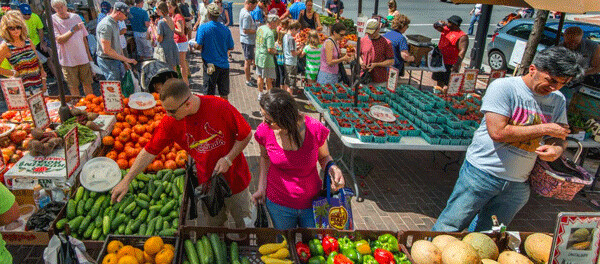News & Articles
Browse all content by date.

Even a small liberal Midwestern city like Bloomington, Indiana can’t escape the division caused by racial demons led by Donald Trump and his Republican minions who both promote white nationalism. Relations among vendors at the farmer’s market in the city of 85,000 and the University of Indiana grew so bad over the subject of white nationalism the mayor suspended the market in July over public safety concerns.
This from the city that survived the calm, cool, collected Coach Bobby Knight on the basketball court. He holds the world’s record for the chair-tossing distance throw. The owners of Schooner Creek Farm, organic growers of tomatoes and kale, seemed to have another organic product for sale - white nationalism. Soon anti-fascist protesters showed up in front of the Schooner Creek Farms vegetable stall. To make a long troublesome story short, soon members of a local conservative militia group—fully armed—marched to support the farm against their anti-fascist enemies.
Market Coordinator Marcia Veldman, organizer of 130 vendors serving up to 12,000 customers, says: “It’s been the most challenging, complex, difficult situation this market has faced in its 45-year history.” The Schooner Creekers and supporters say they are not white supremacists but admit they are “identitarians” who have become members of the American Identity Movement. The Southern Poverty Law Center claims it is a white supremacist group. The word “identity” is key here.
The Christian Identity Church evidently is alive and well in the area. To put it bluntly, members believe that Negroes were created by God to serve whites. Perhaps you remember the Oklahoma City bomber named Timothy McVeigh who killed 168 and wounded 680 in the federal building bombing. He was a member of that church. If you wish to read more about the market incident, read New York Times reporter Jack Healy’s article “Amid the Kale And the Corn, Fears of White Supremacy at the Farmer’s Market.” It’s a microcosm of what’s happening all over Trump country.
Bloomington Protester: “Don’t Buy Veggies From Nazis”
Fliers featuring hooded KKKers were distributed around Bloomington during the market kerfuffle just to remind residents that one of the largest branches of the Ku Klux Klan was once formed in the state. The flier stated it was part of a “neighborhood watch” system. Protesters were frightened by cars driving back and forth by their homes late at night. Shoppers stopped bringing their children to the market. People petitioned the Bloomington City Council to remove Schooner Creek Farm from the vendor list.
There’s “trouble in river city” across the country due to racial divisiveness.. In New Middleton, Ohio police arrested 20-year-old Patrick Reardon on charges of telecommunications harassment and aggravated menacing for threatening to shoot up the Jewish Community Center of nearby Youngstown, Ohio on Instagram. The self-described white nationalist is a veteran of the Charlottesville “Unite the Right” rally where he was interviewed about his views. He said he was a member of the Alt-Right who wants a “homeland for white people.”
He had the means of carrying out his threat. In his parent’s home police found an assortment of weapons and accessories, including knives, two assault rifles, a “large amount” of ammunition, a gas mask, and bulletproof armor. The FBI and local authorities are considering charging him with hate crimes. Reardon is currently in jail with bail set at $250,000. He’s “in a heap” of trouble—and so is the country. In Wynne, Arkansas four black football players going through neighborhoods selling discount cards for their annual high school football fund raiser were met by a white woman with a pistol who forced them all to lie on the ground with legs spread and arms behind their heads.
Two were wearing football jerseys at the time. Several witnesses called police. After the boys explained what they were doing, the woman was arrested for aggravated assault, false imprisonment (both felonies), and four counts of endangering the welfare of a minor. She was booked and bonded but didn’t have a mug shot taken until local people said she was getting special treatment. The students at Wynne High School are 70% white and 28% black and have never had trouble selling fundraiser discount cards before. A grandmother of one of the 16-year-olds quoted her grandson: “Grandma, every time I close my eyes I see that gun.” Yes, folks, there‘s trouble in Wynne Arkansas with a “capital T.” There’s also a heap of trouble in Memphis.
A black teenager named Dorian Harris spent seven seconds in a liquor store, stole a $2 beer, and ran out the door. A white clerk grabbed a pistol, chased Dorian down the street, and put three rounds in his back. The clerk didn’t bother calling 911 or the cops, so Dorian’s body was found in a backyard two days later. Protests, boycotts, and inflamed racial tensions surfaced as hundreds of blacks mourned his death. The clerk was later convicted of second degree murder and is facing 15 to 65 years. Memphis is also a troubled river city.
We Are Celebrating The 400th Anniversary Year Of Black Immigration
In 1619 at least 20 Africans were sold in Point Comfort, Virginia to European colonizers; thus starting at least 350 years of slavery in the United States. At least that’s the opinion of a commentator I heard last week. He claimed that blacks were slaves until the Civil Rights and Voting Acts of 1964 and 1965. An examination of our “real” history proves he’s right. In 1705 Virginia passed a law requiring non-slaveholding whites to staff slave patrols and to cut off slave escape routes.
The Civil War of 1861-1865 did not free the slaves. It simply introduced another 100 years of Jim Crow laws in southern states that required whites to still treat blacks as slaves. We have to remember that during this period well over 4,000 blacks were lynched to maintain control over them. During the 400 years since 1619 blacks always resisted slavery. At least 50 slave “rebellions” were reported in newspapers. Matthew Desmond of the New York Times has written a fascinating article about slavery and capitalism titled “In Order to Understand the Brutality of American Capitalism, You Have To Start on the Plantation.” His central theme: “This is a capitalist society. It is a fatalistic mantra that seems to get repeated to anyone who questions why America can’t be more fair or equal. But around the world, there are many types of capitalistic societies, ranging from liberating to exploitative, protective to abusive, democratic to unregulated.”
The proof of why we live in an exploitative, abusive, and unregulated society rests on facts collected by the Organization for Economic Cooperation and Development (OECD), a group of 34 of the top wealthy and developed nations. In the United States the top One Percent own 40% of the nation’s wealth while a larger share of workers aged 18 to 65 live in poverty than in any other developed OCED nation. One reason is worker rights. In Iceland 90% of wage and salaried workers belongs to trade unions fighting for living wages and good working conditions. In Italy it’s 34%, in Canada, it’s 26%. When at one time 35% of American workers carried union cards, now union membership is down to 10%. American historians are now pointing to the cotton houses and the slave auction blocks for why we have taken the lowest and toughest road to capitalism in the world.
Here’s How We Got To Exploitative. Abusive, Unregulated Disaster Capitalism
In order to get the maximum out of each slave on the cotton plantation, owners made sure that violence had to flow only in one direction—from a small group of armed whites to a much larger mass of enslaved blacks. The standard rule was: “Never allow any slave to lock or unlock any door.” Tools used each day were carefully accounted for at the end of the day so they couldn’t be used as weapons. Planters always had to anticipate rebellion because of an extremely heavy workload.
A North Carolina planter gave these orders to his overseers: “Slaves are to be followed from day break to dark.” The largest plantations often had rows of cotton one-third of a mile long. Starting at day break, faster workers were assigned to the head of the rows. Their job was to try to get all pickers to match them in pounds picked. Slaves who lagged behind were whipped. Children of slaves delivered water to the pickers. Overseers weighed the cotton picked during the long day and kept records of the day’s picking. Pregnant slaves were sometimes assigned to lighter work because children were great assets to be sold later. Nursing mothers were often assigned to “sucklers gangs” so that other mothers could continue to pick cotton.
Plantation slave labor camps became very efficient—and brutal. All work was checked by measurements and rather scientific accounting. Workers at Amazon today are technologically measured and checked during their workday just as slaves on the plantations were measured and checked during hot days in the cotton fields. The core impulse between billionaires like Jeff Bezos of Amazon and plantation owners in Mississippi is to have overwhelming control over the bodies of their enslaved work force. This is how the exploitative, abusive, unregulated, and present-day disaster U.S. capitalism works—and how the One Percent ends up owning almost half of everything.
I Will Believe Corporation CEO Panic When I See Them Chased Down Wall Street
Over the last five years or so we have had some discreet mumblings from a few billionaires and CEOs about the destruction of the middle class and income inequality caused by our form of disaster capitalism.
These diluted messages were often mouthed while they were jetting to remote places buying escape estates in New Zealand or on some remote island—or while they were buying old nuclear missile silos and converting them to end-of-their-world survival bunkers. One has even written a book about inequality. Hedge fund billionaire Ray Dalio writes in his book “How and Why Capitalism Needs to Be Reformed” that our current disaster capitalism must “evolve or die.”
That thought seems to be reaching more of the people who, in their consummate greed, capitalized on control exercised by cotton and sugar millionaires for three centuries in Mississippi and Louisiana—and control exercised by Wall Street bankers and corporation CEOs today. David Ignatius in the Washington Post (owned by Bezos!) wrote this absolutely shocking paragraph in his column “Corporate Panic about Capitalism Could Be a Turning Point”:
“The loudest reform call yet from inside the system came this week from the Business Roundtable, which represents the CEOs of 192 of the nation’s largest companies. Some members declared that making profits for stockholders isn’t a corporation’s main responsibility. Instead, companies have a broader mission to serve customers, employees, suppliers, and communities, too.” This is only one broadside fired at the One Percent pirate ship. All the sails are still up.
| Tweet |


